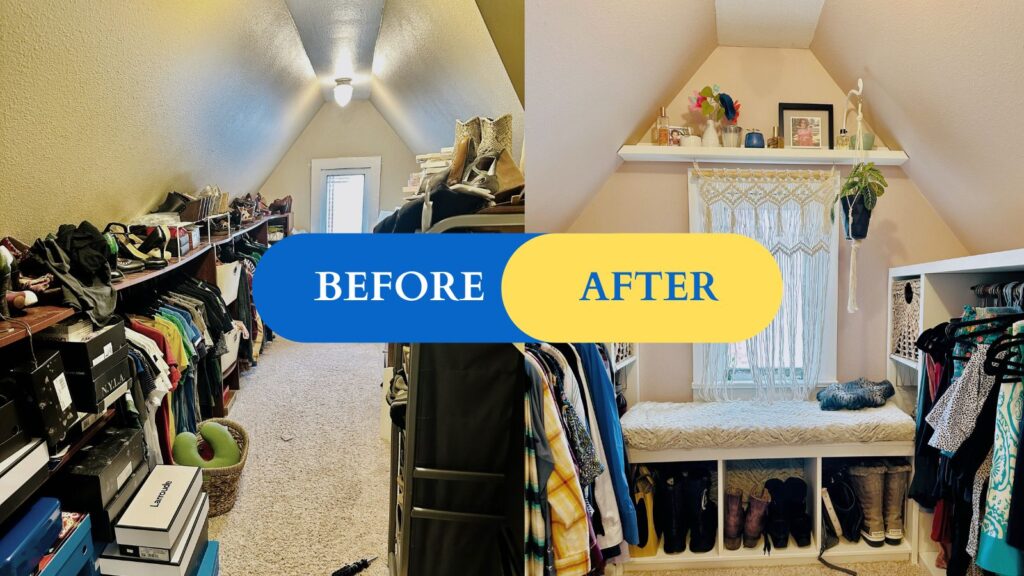How Gwen Tailored a Walk-In Closet for Her 100-Year-Old House

It took 13 years, but Gwen finally conquered the challenge of her century-old home’s walk-in closet. Unlike conventional, rectangular spaces, this one was narrow with oddly angled walls and a pitched ceiling. These quirks made off-the-shelf closet systems a non-starter, forcing Gwen to get creative.
“I bought my 100-year-old home about 13 years ago, and the primary bedroom is attached to part of a more recent bump-out by a previous owner. The extension created a fairly spacious but awkwardly shaped bonus room that was made into a walk-in closet,” she explains.
“The home has dramatic English-style rooflines that define the bonus room and create a long, narrow space with walls only 1 foot tall on the north and 2 feet tall on the south side.” The configuration meant that most premade closet systems would not work for this space.
Old Closet System Was Collapsing
“Originally,” Gwen added, “the previous owners outfitted the space with an inexpensive half-height commercial closet system, most likely the only one available at the time that would fit the space. The setup was flimsy, sagging, and it was time to go.”
After a lengthy research, Gwen stumbled upon the IKEA Hackers community and dove in. Inspired, she devised a plan using IKEA KALLAX shelving units as the backbone of the new closet system.
IKEA items used:
4 KALLAX 4×3
2 KALLAX 3×3
4 KALLAX drawer insert units
4 LUSTIGKURRE baskets
4 KALLAX shelf riser sets
1 HEMNES tall shoe cabinet
1 HEMNES double shoe cabinet
1 PANGET bench
1 MOSSLANDA picture ledge
Other materials used
Wooden closet rails – I used six pieces approximately 30” long each
Wooden rail holders
Gold-colored knobs for dressers
1×12 boards to reinforce closet rails
Hooks and dowels
Crafting A Custom Closet with IKEA KALLAX
Gwen began by prepping and giving the room a fresh coat of paint, trading the dull beige walls for a delicate pale pink hue.
Configuring the KALLAX units
She strategically chose the 4×3 KALLAX units for their height (43”), closely matching the existing system, thereby maximizing the central space. “I already had several 4×4 KALLAX units and wanted to repurpose them as much as possible. So I bought two 3×3 KALLAX units and reconfigured them with two 4×4 units to create four 4×3 units.”
Space for hanging clothes
“I built these with the long shelf situated vertically and used the small shelves on the outside only, so I had a 3×2 space in the center to place the closet rail. The room space allowed for one more unit on the north side, so I used an additional 3×3 unit on that end, building that one similarly with a 3×2 space for a rail and cubes on the outside,” she says.
Reinforcing the clothes rail
Aware of the potential strain on the shelves from the weight of her clothing, Gwen reinforced the inner vertical walls of each unit.
“I cut down the long unused shelves from my 4×4 units that I had leftover and pressed them onto the protruding pegs to secure them and remove the need to cut off the peg ends.”
Reinforcing the clothes rail with shelf board
I didn’t have enough of these shelves to reinforce all of the sides this way, so for the rest, I purchased a 1×12 shelf board, cut it to the length of the space, and primed and painted it white. I sawed off the peg ends on those sides and screwed the boards into place with wood screws, then attached the closet rail brackets with longer screws through both boards to secure them.”
Adding a bench
Gwen discovered that the space between the two rows of shelf units perfectly accommodated a PANGET storage bench, which she promptly added to the design.
Shoe storage
To achieve a cohesive look, she bought two secondhand HEMNES shoe cabinets and replaced their hardware to match the rest of the setup. She lined all the drawers with new wallpaper to further personalize the units.
Storage for accessories
To further customize her closet, Gwen installed Command hooks in a gold finish at the ends of the KALLAX units. The hooks support a dowel with additional hooks for hanging accessories.
Framing it
Over the window, she repurposed an old IKEA picture ledge (similar to the current MOSSLANDA model), which required some modification. Due to the steep roofline angles, Gwen crafted a template and carefully sawed the ends with her Japanese pull saw to ensure a snug fit, even carving out a wedge to accommodate a plant hanger.
Final touches
The final touches included the installation of KALLAX drawers, LUSTIGKURRE baskets, and various hooks on the walls.
Time and cost of the KALLAX closet
The entire project spanned approximately one whole weekend of work, though Gwen spread it over just over a week for convenience.
Project cost:
3-3×3 KALLAX: 120 x 3 = $360 USD
4-drawer sets: 20 x 4 = $80
Shelf risers: 4 x 15 = $60
PANGET bench: $250
HEMNES cabinets: $200 (secondhand)
1×12 board: $38
Closet rods: $50
Brackets, hooks, hardware: $50
Total: $1098 (plus paint) (Not included: items I already owned and repurposed, two 4×4 KALLAX and 1 picture ledge)
A functional walk-in wardrobe
Gwen’s favorite aspect of her KALLAX closet hack is the clean, sturdy feel it exudes, and she is confident that it will withstand heavy use for years. She also takes pride in repurposing existing pieces for a new functional purpose.
What was hardest in this DIY project?
For the most part, Gwen didn’t find the project hard. “Once I realized I could swap out parts from two different KALLAX units to make the size I needed rather than buying entirely new pieces, the project took off. Buying used kept my costs down considerably.”
The most challenging part of the project was ensuring the closet rails were adequately supported. Gwen had to figure out the precise length of the supporting lumber to fit smoothly into the closet and bear the weight of her extensive wardrobe.
What to pay special attention to?
For those looking to replicate her hack, Gwen advises paying particular attention to the length of the supporting lumber for the closet rails, as it is crucial for a seamless fit and sufficient support.
Reflecting on the process, Gwen mentions that while she was initially concerned about the sturdiness of secondhand pieces, in hindsight, sourcing all components from the secondhand market could have significantly reduced costs without compromising the project’s success.
Read Next
The post How Gwen Tailored a Walk-In Closet for Her 100-Year-Old House appeared first on IKEA Hackers.







